 Having lived and worked throughout Asia over the past few years, I am continually reminded that the Generation Gap that I wrote about in China’s Generation Y applies to many Asian cultures—China and beyond.
Having lived and worked throughout Asia over the past few years, I am continually reminded that the Generation Gap that I wrote about in China’s Generation Y applies to many Asian cultures—China and beyond.
In my book China’s Generation Y, I spent one chapter describing the significant generation gap between Gen Y’s parents, who grew up under the cultural revolution, and today’s youth who are in a peaceful consumerist country that has only seen growth. My research showed that young people would not speak to their parents about many things and would avoid talking about even their interests like computer games to avoid criticism from their protective parents.
In India, I met with the parents of young people. They described how it wasn’t the transitions to a new marketplace or the new technologies that bother them. It was that young people were abandoning their culture or Western ideals. That is not to say they were particularly angry or condescending about Western culture. Rather, it was the abandonment of the Indian collectivist ideals to more individualist ideals which concerned them.
In the Gulf states of the Middle East, I was involved with research projects with young local Arab consumers. Indeed the collectivist culture is just as strong as in China and India. To my surprise, the same generation gap applies. Young people have remarkably distinguishable rules and perceptions on what they can and cannot say to their parents.
Now, young women who would wear burqu’as in public are even likely to play playstation at home. While Arab youth are far less likely to follow the same trajectory as Chinese youth (e.g. consumerist, increasingly Western), they still watch Western media and partake in activities with their friends that put them at odds with elders.
These experiences and the corresponding market research on young people lead me to believe that the Generation Gap is a more global phenomenon, heavily impacting Asia due to the impact of traditional culture with a new global culture. The result is that young people are bridging the gap and thus creating a palpable generation gap, which far exceeds those in developed countries.
SIS International Market Research, Business Intelligence & Strategy, 2008.


